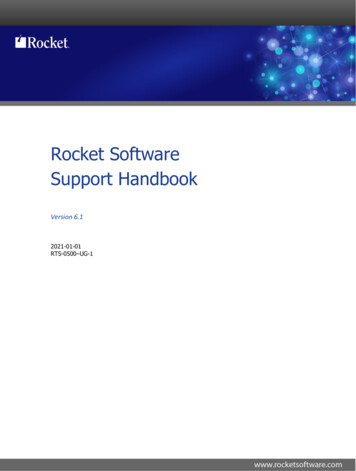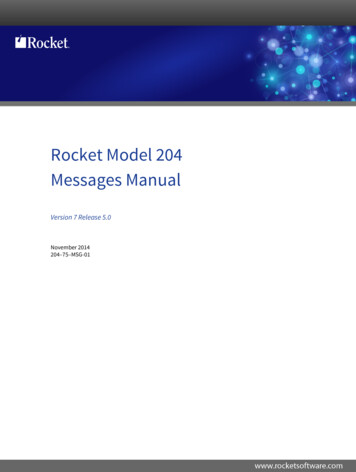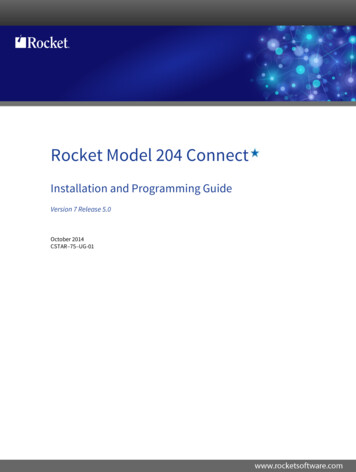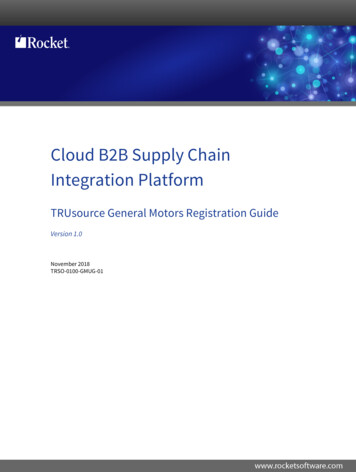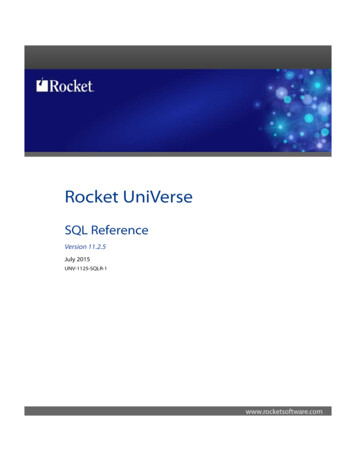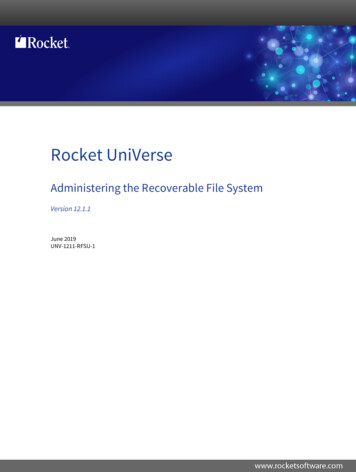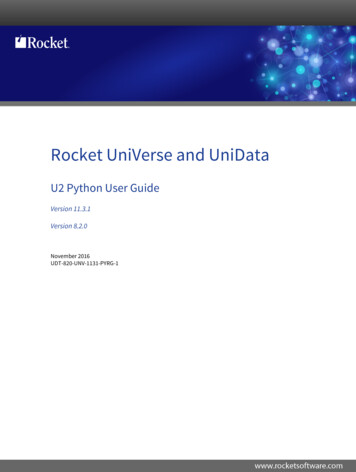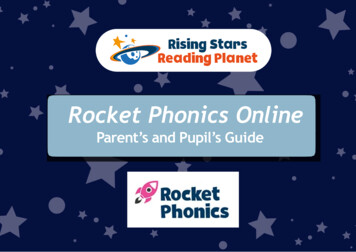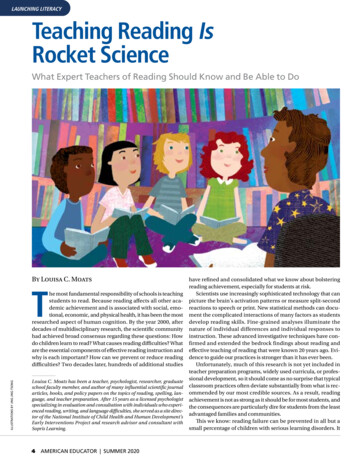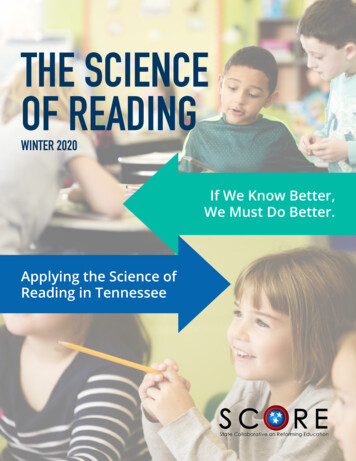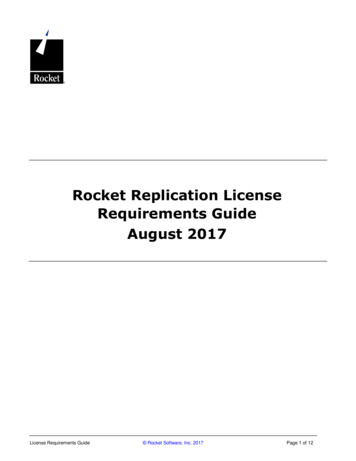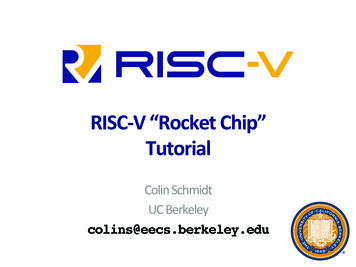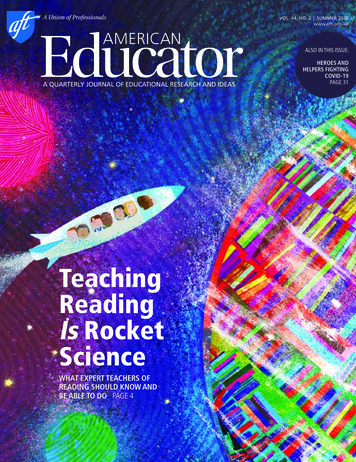
Transcription
VOL. 44, NO. 2 SUMMER 2020www.aft.org /aeALSO IN THIS ISSUE:HEROES ANDHELPERS FIGHTINGCOVID-19PAGE 31TeachingReadingIs RocketScienceWHAT EXPERT TEACHERS OFREADING SHOULD KNOW ANDBE ABLE TO DO PAGE 4
First Book:Supporting AFTEducators andKids at HomeCOVID-19 has shuttered schools, leaving kids in povertywithout what may be their only access to the internetor books, and making at-home learning especiallychallenging. For every child in need, however, there is aneducator who is working, creating and innovating to makesure their kids don’t fall behind.Are you supporting kids and families livingin poverty through a community program oremergency service during theCOVID-19 pandemic?The AFT and First Book are doing everything we can tosupport educators like you to help keep kids in needengaged during this crisis with resources like these:If you are, First Book is seeking funders toprovide books and educational resources tohelp these heroic efforts. Free educational tools and activities you canuse or share directly with your students and theirfamilies that don’t require internet access or rces Free, downloadable resources full of funat-home reading, math and critical-thinking activitiesfor children in grades preK-8; available in Englishand Spanish.bit.ly/timeathomebit.ly/tiempoencasa Supporting At-Home Learning section—aone-stop shop for low-cost, brand-new books, schoolsupplies and digital learning resources for kids frombirth to age 18.fbmarketplace.org/athomelearningHelp us show the huge need and fill out theFunding Support Interest Form, whichwill be included in the First Book COVID-19Activation Network.bit.ly/firstbookCOVID-19relief
WHERE WE STANDFor the Love of ReadingRANDI WEINGARTEN, AFT PresidentI LOVE TO READ, although these days I domuch of it on a computer screen. As achild I remember my mother, who was asecond-grade teacher, always making surewe had books at home—books like TheHundred Dresses by Eleanor Estes, The JazzMan by Mary Hays Weik, and The Story ofFerdinand by Munro Leaf. Books I read asa teenager shaped my quest forjustice and the fight againstdiscrimination—books likeAnne Frank’s The Diary of aYoung Girl and Harper Lee’s ToKill a Mockingbird. And I willalways be mesmerized by EmmaLazarus’ iconic poem, “The NewColossus” with such lyricallanguage as “The wretchedrefuse of your teeming shore . I lift mylamp beside the golden door!”Even as much of my time, before andduring the pandemic, is devoted tofighting for our members, our students,and our communities, I try to make timefor reading. Whether it’s for work or forpleasure, I read to stay informed, to sparknew ideas, to renew my spirit, and to betterunderstand others’ perspectives. I can’timagine my life without the writtenword—and I’m grateful to the teachers,including my mother, who gave me the giftof reading when I was young.Reading is not simply a desire; it is afundamental skill necessary for virtuallyeverything we do. And we need to ensureall of us, particularly our children, learn toread and read to learn so they too can doeverything. That’s why the AFT is pleasedto update and republish Teaching ReadingIs Rocket Science, 2020: What ExpertTeachers of Reading Should Know and BeAble to Do. This report, written by LouisaC. Moats (a teacher, psychologist,researcher, and professor who has been atthe forefront of science-based readinginstruction for five decades) translates thelatest reading research into accessiblelanguage so that those of us who are notsteeped in the pedagogy of reading canapply it to our own teaching and learning.Let me tell you what the report doesand doesn’t do. It doesn’t get us back intothe reading wars, and it doesn’t advocatefor what we have found so disrespectful:scripted curricula or “teacher proof”programs. It does detail the expert-levelknowledge of language necessary to teachcountless hours searching online tosupplement the inadequate materials andtraining they have been given. So much ofwhat sounds persuasive on paper justdoesn’t work well in the classroom—orworks well only for students who mosteasily master the art and science ofreading. This report tries to fill that void.The science of reading is inextricably linked to the loveof reading. To teach and inspire the next generation,we simply can’t have one without the other.reading, and it does support teachers inbuilding that knowledge.In disseminating effective practicesgrounded in research, everyone has a roleto play. From teacher-preparationprograms to school systems, from stateofficials to curriculum developers, wemust move quickly to revamp the guidance and resources provided to educators.But I’m betting on our nation’s teachers.This pandemic has shown everyone whatany of us who have spent five minutes withteachers know: as a profession we have thedrive and the passion to do the hard workof understanding and using the science ofreading. And it is hard work, much harderthan it should be since so few of theeducation publishers and professionaldevelopment providers have cast asidetheir profitable-but-outdated materialsand programs to create new resources thatreflect the latest research.The current state of reading researchunderstands the importance of teacherprofessionalism and autonomy. Embracing the science is, fundamentally, aboutgiving teachers the freedom to teach.Teachers’ hearts break when studentsstruggle to decipher words on a page andexplain what they mean. Desperate tosupport those students, teachers spendMoats, who has dedicated her career tostruggling readers, wrote the first versionof Teaching Reading Is Rocket Science,which the AFT published, in 1999. In it,she explained how children learn to read,the essential components of readinginstruction, what causes reading difficulties and how to prevent or reduce them. Inthis new edition, she adds depth to thescience and provides clarity on thechallenge before us: taking action.Teaching reading really is rocketscience. Academic English is complex.Given this complexity, children needcarefully planned instruction to becomefluent readers, spellers, and writers. And,because of the enormous inequities inour society, providing each child anequitable opportunity to revel in anabundance of books in which they bothsee themselves and are introduced to theworld is no small task.Still, there is joy in this work—whetherreading aloud stories and poems thatdelight young and old, or introducing thewonder of new words and ideas tochildren. Ultimately, the science ofreading is inextricably linked to the love ofreading. To teach and inspire the nextgeneration, we simply can’t have onewithout the other.AMERICAN EDUCATOR SUMMER 20201
Download this issue for free at www.aft.org/ae.VOL. 44, NO. 2 SUMMER 2020www.aft.org /aeOUR MISSIONLAUNCHING LITERACY4Teaching Reading Is Rocket ScienceWhat Expert Teachers of Reading Should Know and Be Able to DoBy Louisa C. MoatsThe science of reading indicates that literacy instruction must be explicit andsystematic, developing everything from decoding skills to content knowledge.Yet critical factors, including teacher preparation and literacy curricula, areoften not aligned with this science. To ensure that more children become strongreaders, many systems, policies, and supports need to be revamped now.10The Reading LeagueWhether listening to a read-aloudor grappling with a complex text,students’ knowledge and vocabulary impact their comprehension.Young children can learn aboutwords and the world by engagingwith a series of texts on selectedtopics over time.Prioritizing Educator Knowledgethrough Grassroots ActivismBy Maria MurrayA former college professor reflectson the challenges that led her tofound an organization to promoteeffective reading instruction.13Limiting Children to BooksThey Can Already Read22Celebrating OurLinguistic StrengthsWhy It Reduces TheirOpportunity to LearnBy Chan LüBy Timothy ShanahanAlthough matching students withbooks at their “just right” level is awidespread practice, it oftendoesn’t maximize student learning.A more effective approach issupporting students as they read avariety of texts, including thosethey find challenging.18Bilingualism andBiliteracy for AllBuilding Knowledge28What an Elementary SchoolCurriculum Should Do31EVELYN DEJESUSExecutive Vice PresidentLISA HANSELChief Publications EditorJENNIFER DUBINManaging EditorLUKE STEELEEditorial CoordinatorSEAN LISHANSKYCopyeditorSOPHIA GRABIECCopyediting FellowJENNIFER CHANGArt DirectorOn the Road to Literacy withAmerican EducatorAMERICAN EDUCATOR cannot assume responsibility forunsolicited manuscripts.Heroes and Helpers Fighting COVID-19By Randi WeingartenThis special package highlights AFT members’extraordinary efforts to support their students,patients, families, and communities and alsooffers a wide range of social-emotional,academic, and financial resources.AMERICAN EDUCATOR SUMMER 2020LORRETTA JOHNSONSecretary-TreasurerJENNIFER BERNEYGraphic DesignerWe Are All in This Together2RANDI WEINGARTENPresidentSpeaking more than one languagehas many benefits for individuals’cognitive development and for ournation’s democracy and economy.But too often, when a studentspeaks a language other thanEnglish at home, that asset is notappreciated as it deserves to be.Highlights from the Archive toSupport Research-Based ReadingInstructionBy Natalie WexlerThe American Federation of Teachers isa union of professionals that championsfairness; democracy; economicopportunity; and high-quality publiceducation, healthcare and publicservices for our students, their familiesand our communities. We are committedto advancing these principles throughcommunity engagement, organizing,collective bargaining and politicalactivism, and especially through the workour members do.RACHEL ANDERSONProduction AssistantAMERICAN EDUCATOR (ISSN 0148-432X, USPS 008-462)is published quarterly by the American Federation ofTeachers, 555 New Jersey Ave. NW, Washington, DC20001-2079. Phone: 202-879-4400. www.aft.orgLetters to the editor may be sent to the address aboveor to ae@aft.org.Please allow a minimum of four weeks for copyrightpermission requests.Signed articles do not necessarily represent theviewpoints or policies of the AFT.AMERICAN EDUCATOR is mailed to AFT teachers andearly childhood members as a benefit of membership.Subscriptions represent 2.50 of annual dues. Non-AFTmembers may subscribe by mailing 10 per year bycheck or money order to the address below.MEMBERS: To change your address or subscription,notify your local union treasurer or visit www.aft.org/members.POSTMASTER: Send address changes to AmericanEducator, 555 New Jersey Ave. NW, Washington, DC20001-2079.Periodicals postage paid at Washington, DC, andadditional mailing offices. 2020 AMERICAN FEDERATION OF TEACHERS, AFL-CIOCover illustration:JING JING TSONG
LAUNCHING LITERACYsharemylessonBy Educators, For EducatorsTeaching Students to Readin which children match initial phonemes tographemes (letters and letter combinationsthat represent phonemes/sounds) by sortingpictures based on initial sounds into 26 paperbags labeled with each letter of the alphabet.Language ComprehensionWhile learning to sound out words isessential, comprehension relies on muchmore—like academic knowledge, vocabulary, and familiarity with complex sentencestructures. The Center offers severalresources to support students in strengthening language comprehension.For example, in the “Classifying Info”activity students write words or phrases in agraphic organizer that describe and/or relateto a category of a topic based on an expository text. One graphic organizer the Centerrecommends to help students monitor theirunderstanding is a K-W-L chart. In threeseparate columns, students keep track ofwhat they already know about a text (K),what they would like to learn (W), and whatthey learned after reading the text (L).Another activity the Center suggests isa “Classic Classifying” graphic organizer,in which students write at least fourwords or phrases that describe and/orrelate to a category of a topic. Forinstance, if the text is about a lion,students could create categories such as“food,” “home,” “appearance,” and“behavior,” and thus keep track of whatthey learn. Finally, “Expository Exploration,” is another of the Center’s activitiesin which students create a graphicorganizer to help them examine andidentify a text’s main idea and details.Teaching students to read so theybecome lifelong learners—and experiencethe joy of reading—is of the utmostimportance. To see the thousands of otherliteracy supports Share My Lesson offers,visit our entire collection of lesson plans,resources, and activities. If you haveadditional ideas or requests, please reachout to us at content@sharemylesson.com.–THE SHARE MY LESSON TEAMGETTYIMAGES/SDI PRODUCTIONSAs Louisa C. Moats writes in this issue’scover article, “the most fundamentalresponsibility of schools is teaching studentsto read.” Fortunately, there is now a strongresearch base to guide literacy instruction—but relatively few teacher preparationprograms, curricula, or other resourcesintended to support teachers currently buildon that research. Today, about 20 percent ofelementary school students across thecountry struggle with learning to read, andanother 20 percent are not meetinggrade-level expectations in reading. Butthese nationwide averages mask a tragedy:among students growing up in underresourced communities—mainly AfricanAmerican and Hispanic students andstudents whose home language is notEnglish—about 60 to 70 percent have weakreading skills. This issue can largely beaddressed now and avoided in the future.The current science of reading is complex,requiring high-quality materials andfocused instruction over several years. Butresults are heartening, with all but about 5percent of children learning to read well.In summarizing that science, Moatspresents a conceptual model known as theSimple View of Reading, which “states thatreading comprehension is the product ofword recognition and language comprehension. Without strong skills in eitherdomain, an individual’s reading comprehension will be compromised.” Share My Lessonhas resources to help.Here, we highlight materials created bythe Florida Center for Reading Research, aninterdisciplinary research center at FloridaState University that has nearly 40 resourcesavailable through Share My Lesson.Word RecognitionTo develop word recognition, phonological awareness is essential. One resourcefrom the Center suggests using a pictureslide so students can segment and blendphonemes (speech sounds) in words.Another activity engages children inpracticing phoneme segmenting andblending; it uses Elkonin Box picturecards—as children say what they see in thepicture, e.g. fish, they place a token in abox for each phoneme they hear.Playing with language is also fun with theCenter’s “Treasure Chest” game, in whichstudents take turns segmenting words intophonemes and blending them to use as clues.Another enjoyable activity is “Brown Bag It”Recommended ResourcesThe Florida Center forReading Researchhttp://go.aft.org/ae220sml1Treasure Chest—PhonemeSegmenting and Blendinghttp://go.aft.org/ae220sml4K-W-L Chart—Monitoringfor Understandinghttp://go.aft.org/ae220sml7Picture Slide—PhonemeSegmenting and Blendinghttp://go.aft.org/ae220sml2Brown Bag e220sml5Classic Classifying—Expository Text Structurehttp://go.aft.org/ae220sml8Phoneme Split andSay Activityhttp://go.aft.org/ae220sml3Classifying Info—Monitoring for Understandinghttp://go.aft.org/ae220sml6Expository Exploration—Expository Text Structurehttp://go.aft.org/ae220sml9AMERICAN EDUCATOR SUMMER 20203
LAUNCHING LITERACYTeaching Reading IsRocket ScienceWhat Expert Teachers of Reading Should Know and Be Able to DoBy Louisa C. MoatsTILLUSTRATIONS BY JING JING TSONGhe most fundamental responsibility of schools is teachingstudents to read. Because reading affects all other academic achievement and is associated with social, emotional, economic, and physical health, it has been the mostresearched aspect of human cognition. By the year 2000, afterdecades of multidisciplinary research, the scientific communityhad achieved broad consensus regarding these questions: Howdo children learn to read? What causes reading difficulties? Whatare the essential components of effective reading instruction andwhy is each important? How can we prevent or reduce readingdifficulties? Two decades later, hundreds of additional studiesLouisa C. Moats has been a teacher, psychologist, researcher, graduateschool faculty member, and author of many influential scientific journalarticles, books, and policy papers on the topics of reading, spelling, language, and teacher preparation. After 15 years as a licensed psychologistspecializing in evaluation and consultation with individuals who experienced reading, writing, and language difficulties, she served as a site director of the National Institute of Child Health and Human Development’sEarly Interventions Project and research advisor and consultant withSopris Learning.4AMERICAN EDUCATOR SUMMER 2020have refined and consolidated what we know about bolsteringreading achievement, especially for students at risk.Scientists use increasingly sophisticated technology that canpicture the brain’s activation patterns or measure split-secondreactions to speech or print. New statistical methods can document the complicated interactions of many factors as studentsdevelop reading skills. Fine-grained analyses illuminate thenature of individual differences and individual responses toinstruction. These advanced investigative techniques have confirmed and extended the bedrock findings about reading andeffective teaching of reading that were known 20 years ago. Evidence to guide our practices is stronger than it has ever been.Unfortunately, much of this research is not yet included inteacher preparation programs, widely used curricula, or professional development, so it should come as no surprise that typicalclassroom practices often deviate substantially from what is recommended by our most credible sources. As a result, readingachievement is not as strong as it should be for most students, andthe consequences are particularly dire for students from the leastadvantaged families and communities.This we know: reading failure can be prevented in all but asmall percentage of children with serious learning disorders. It
Policies and systems currently impacting how reading is taughtneed to improve—dramatically and rapidly.is possible to teach most students how to read if we startearly and follow the significantbody of research showing whichpractices are most effective. Students living in poverty, studentsof color, and students who areeligible for remedial servicescan become competent readers—at any age. Persistent “gaps”between more advantaged andless advantaged students can be narrowed and even closed.Fundamentally, these gaps are the result of differences in students’ opportunities to learn—not their learning abilities.Although educators have long understood the importance ofliteracy, teaching children to read is very complex. Far too manychildren have trouble reading and writing. About 20 percent ofelementary school students nationwide have serious problemslearning to read; at least another 20 percent are at risk for notmeeting grade-level expectations.1 For children growing up inunderresourced communities and attending underresourcedschools, the incidence of reading failure is astronomical and completely unacceptable. Students who are African American, Hispanic, learning English, and/or from impoverished homes fallbehind and stay behind in far greater proportion than studentswho are white and middle class. The rate of weak reading skills inthese groups is 60–70 percent, according to the National Assessment of Educational Progress.2The tragedy here is that most reading failure is unnecessary.We now know that classroom teaching itself, when it includes arange of research-based components and practices, can preventand mitigate reading difficulty. Although home factors do influence how well and how soon students read, informed classroominstruction that targets specific language, cognitive, and readingskills beginning in kindergarten enhances success for all but avery small percentage of students with learning disabilities orsevere dyslexia. Researchers now estimate that 95 percent of allchildren can be taught to read by the end of first grade, withfuture achievement constrained* only by students’ reasoningand listening comprehension abilities.3While parents, tutors, and the community can contribute toreading success, classroom instruction is the critical factor inpreventing reading problems and must be the primary focus forchange.4 To be clear: although the day-to-day work is teachers’responsibility, students’ reading success is our shared responsibility. From preparation programs to standards and assessments tocurricula and professional development, the policies and systems*It is important to note that students’ reasoning and comprehension abilities can alsobe enhanced through informed instruction. As students’ subject-matter knowledgeand vocabulary grow, so will their capacity to think critically.currently impacting how reading is taught need to improve—dramatically and rapidly. Teaching reading is rocket science. But it isalso established science, with clear, specific, practical instructional strategies that all teachers should be taught and supportedin using.Research-Validated Ideas for InstructionA well-validated concept that should underpin the design ofinstruction is called the Simple View of Reading.5 It states thatreading comprehension is the product of word recognition andlanguage comprehension. Without strong skills in either domain,an individual’s reading comprehension will be compromised.A reader’s recognition of printed words must be accurate andautomatic to support comprehension. The development of automatic word recognition depends on intact, proficient phonemeawareness, knowledge of sound-symbol (phoneme-grapheme)correspondences, recognition of print patterns such as recurringletter sequences and syllable spellings, and recognition of meaningful parts of words (morphemes).6 Young readers progress bygradually learning each of these ways that our print systemrepresents language, and then applying what they know duringample practice with both oral and silent reading. If reading skillis developing successfully, word recognition gradually becomesThis article is an excerpt of Teaching Reading Is RocketScience, 2020: What Expert Teachers of Reading ShouldKnow and Be Able to Do, which emerged from a collaboration between the American Federation of Teachers and theCenter for Development and Learning.In this report, Louisa C. Moats calls for teacher preparation and professional development to be more rigorous andbetter aligned with decades of reading science. She describesthe knowledge that undergirds successful instruction andconcludes with recommendations for the professionalpreparation of all teachers ofreading. It is our nation’sdedicated teachers and theirexcellent teaching that willbring the rocket science thatTeaching Readingis research-based readingIs Rocket Science,instruction to classrooms2020across the country and willunlock the power and joy ofreading for our children.Teachers, administrators,What ExpertTeachers ofprofessors, and district andReading ShouldKnow and Bestate leaders are encouragedAble to Doto read the full report byvisiting www.aft.org/sites/default/files/Moats.pdf.By Louisa C. MoatsAMERICAN EDUCATOR SUMMER 20205
Persistent “gaps” between more advantaged and less advantagedstudents are the result of differences in students’ opportunities to learn.so fast that it seems as if we are reading “by sight.” The path tothat end, however, requires knowing how print representssounds, syllables, and meaningful word parts; for most students,developing that body of knowledge requires explicit instructionand practice over several grades.7 While some students seem tofigure out how the print system works through incidental exposure, most do not.Language comprehension, the other essential domain thatunderlies reading comprehension, depends on backgroundknowledge, vocabulary, ability to decipher formal and complexsentence patterns, and recognition of the devices that hold a texttogether.8 Furthermore, language comprehension is facilitatedby metacognitive skills such as monitoring whether reading ismaking sense and choosing to act if it does not. The languagecomprehension factor in overall reading achievement becomesmore and more important from about fourth grade onward.9From preschool through high school, students gain vital exposure to a variety of text forms, language patterns, backgroundknowledge, and vocabulary both by listening to text read aloudand by reading itself.The implications of the Simple View of Reading should be selfevident: reading and language arts instruction must includedeliberate, systematic, and explicit teaching of word recognitionand must develop students’ subject-matter knowledge, vocabulary, sentence comprehension, and familiarity with the languagein written texts. Each of these larger skill domains depends on theintegrity of its subskills.Learning to read is a complex achievement, and learning toteach reading requires extensive knowledge and skills across thecomponents of word recognition, language comprehension,spelling, and writing. Consider what the classroom demands of6AMERICAN EDUCATOR SUMMER 2020the teacher. Children’s interest in reading must be stimulatedthrough regular exposure to interesting books and through discussions in which students respond to many kinds of texts. For bestresults, the teacher must instruct the majority of students directly,systematically, and explicitly to decipher words in print, all thewhile keeping in mind the ultimate purpose of reading, which isto learn, enjoy, and understand. To accommodate children’s variability, the teacher must assess children and tailor lessons toindividuals or groups. This includes interpreting errors, givingcorrective feedback, selecting examples to illustrate concepts,explaining new ideas in several ways, and connecting word recognition instruction to meaningful reading and writing.Some children learn language concepts and their applicationvery easily in spite of incidental teaching, but others never learnunless they are taught in an organized, systematic, efficient wayby a knowledgeable teacher using a well-designed instructionalapproach. Children of average ability might learn enough aboutreading to get by if their instruction is haphazard; with systematicresearch-based instruction, those students could achieve muchmore, such as the appreciation for language structure that supports learning words from context, perceiving subtle differencesin meaning, or refining language use.Toward a Curriculum on the Science of ReadingA core curriculum on effective literacy instruction for pre-serviceand in-service teacher education would, of course, be supplemented and honed over time, but its goal is to bring continuity,consistency, quality, and comprehensiveness to the many different programs, organizations, and systems through whichaspiring and current teachers receive information about how toteach reading. Given the current science of reading, this coreshould be divided roughly into the following four areas:1. Knowing the basics of reading psychology and development;2. Understanding language structure for both word recognitionand language comprehension;3. Applying best practices in all components of reading instruction; and4. Using validated, reliable, efficient assessments to inform classroom teaching.This excerpt offers an introduction to the first two areas. For adetailed discussion of all four areas, please see the full . Reading Psychology and DevelopmentLearning to read is not natural or easy for most children. Unlikespoken language, which is learned with almost any kind of contextual exposure, reading is an acquired skill. Although surrounding children with books will support reading development, and a“literature-rich environment” is highly desirable, it is not sufficient for learning to read. Neither will exposure to print ordinarily
A reader’s recognition of printed words must be accurate andautomatic to support comprehension.be sufficient for learning to spell, unless organized practice isprovided. Thus, teachers must be reflective, knowledgeable, andintentional about the content they are teaching—that is, the symbol system (orthography) itself and its relationship to meaning.Good readers do not skim and sample the text when they scana line in a book. They process the letters of each word in detail,although they do so very rapidly and unconsciously. Those whocomprehend well accomplish letter-wise text scanning with relative ease and fluency. When word identification is fast and accurate, a reader has ample mental energy to think over the meaningof the text. Knowledge of sound-symbol mapping is crucial indeveloping word recognition: the ability to sound out and recognize words accounts for about 80 percent of the variance in firstgrade reading comprehension and continues to be a major (albeitdiminishing) factor in text comprehension as students progressthrough the grades (and students’ background knowledge andvocabulary become ever-larger factors in comprehending academic texts).11The ability to sound out words is, in fact, a major underpinningthat allows rapid recognition of words. (This recognition is so fastthat some people mistakenly believe it is happening “by sight.”)Before children can easily sound out or decode words, they musthave at least an implicit awareness of the speech sounds that arerepresented b
Free, downloadable resources full of fun at-home reading, math and critical-thinking activities . I LOVE TO READ , although these days I do much of it on a computer screen. As a . reading aloud stories and poems that delight young and old, or introducing the wonder of ne
